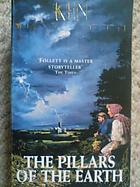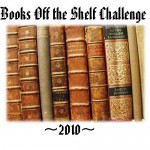Review: ‘The Pillars of the Earth’ by Ken Follett

 Title: The Pillars of the Earth
Title: The Pillars of the Earth
Author: Ken Follett
Published: Pan, 1999, pp. 1076. Originally published 1989
Genre: Historical fiction
Blurb: 1123. A time of violent civil war, famine, religious strife and battles for royal succession And a time when man’s greatest skills and aspirations gave birth to a daring and impossible dream — the building of the magnificent cathedral of Kingsbridge.
For the next tow generations men and women will struggle against their primitive surroundings to create something eternally beautiful. Men like Father Philip, who has dedicated his life to immortality in stone. Or Tom Builder, the architect of his awesome vision. Women like Aliena, the Earl’s beautiful daughter, with the indomitable spirit to overcome a multitude of evils. And Ellen woman of the forest who casts a terrifying curse…
When, where and why: In my final year of university I lived with a girl whose favourite book this was, so naturally I picked it up when I saw a copy in Oxfam. I started reading it because I wanted to keep ahead of the television series, which I’ve actually ended up not watching, oddly enough. It’s definitely old enough to qualify as book 25/50 for my Books Off the Shelf Challenge.
What I thought: I started The Pillars of the Earth full of expectations that I would love it: on the surface this epic of medieval life and cathedrals should have been the perfect book for me. The middle ages is an era that has been very close to my heart ever since I was taken on trips to visit castles and cathedrals by my parents when I was tiny. I went on to take a degree and masters focusing on medieval literature, so I flatter myself that I know a little bit about the period in which this novel is set. Admittedly, my expectations of this book were perhaps a little high (although understandable given the near universally glowing reviews it seems to have garnered) but nonetheless, I wasn’t prepared for the enormous disappointment that this book turned out to be.
I’m not a huge stickler for accuracy in historical fiction as long as the book feels right and for me, this means getting the little details about everyday life correct. It’s easy to get the date of a battle or a coronation correct, but knowing about how ordinary people went about their daily business is more difficult and is part of what I expect from a well-written historical novel. Getting these things wrong sets my teeth on edge normally, but getting them wrong when you spent ten years researching and writing a book (not to mention having a paid research assistant) just looks like laziness and sloppy work. When you have the time, money and resources to get things right there’s just no excuse, as far as I’m concerned. This probably wouldn’t irritate me nearly as much as it does if it weren’t for the numerous reviews that suggest that people could read this book to find out about twelfth century history when all they would learn about is Ken Follett’s twelfth century history, where women are ‘hot’ and ‘sexy’, people have scullery maids and labourers have clothes which do up with multiple buttons, which is about as accurate as Hollywood twelfth century history.
Follett obviously has very fixed notions about the middle ages, which he presents as a lawless, ignorant and violent time with only a few good, educated, enlightened people (strangely enough, the ones that we’re supposed to like) among all the bad. The Anglo-Saxon Chronicle observes that King Stephen’s reign ‘when Christ and his saints slept’ was definitely a lawless and troubled one, so William Hamleigh’s actions are not unlikely, but the divide between good characters who posess modern virtues and bad characters who conform in every way to the medieval stereotype is very heavy-handed and does not make for balanced, believable characters. I half expected the bad characters to cackle while rubbing their hands with glee, they were so one dimensional.
One particular way in which Follett distinguishes his good characters from bad through giving them contrasting ‘modern’ and ‘medieval’ values is sex. The good characters know about things like love, mutual pleasure and orgasms, while the bad characters are either impotent or violent and prefer prostitutes and rape to loving partners. Even if the sex scenes (of which there are many) had been well done, this would have been a crass and obvious way to show characterisation, but they are either repellent or amusingly Harlequin-esque, both of which seem totally out of place in a book ostensibly about building a cathedral. I’m no prude, and I have no objections to the odd well-placed steamy scene in a book, but these seem totally out of context and make me cringe and wish that Follett had learned the technique of tastefully drawing a veil on proceedings. Also, how many times do we need to read a graphic description of William Hamleigh raping a woman to establish that he is A Bad Man? Apparently the answer is many.
The plot is quite repetitive. That might sound reasonable for a novel surrounding something like the construction of a cathedral which necessarily takes place over many decades, but there was never any sense of progression. Tom/Alfred/Jack builds something, William/Waleran causes problems and halts the building, Philip and co. come up with a solution and building continues. Over and over again. If quickly felt as if the book could happily have been much shorter without changing much at all. I thought the end section concerning the murder of Thomas Beckett was very odd and unnecessary, considering how removed it was from the entirety of the plot so far. Kingsbridge is supposedly near Winchester, so why Follett contrives to have it’s Prior be in Canterbury on the night its archbishop is killed perplexes me. All it did was draw the book out even longer, and I was rather losing patience by this point.
When a plot meanders and repeats like this one does it needs strong characters to help drive it along and sadly I found Pillars of the Earth to be lacking in this area too. I was instantly put off by the fact that they all seem to be modern people (with the exception of the bad guys, of course) speaking in modern terms who just happen to be wandering about in period costume (and inaccurate costume at that). The two female characters are both beautiful, resourceful and educated and while I can believe that Aliena might be able to read, the likelihood of forest woman Ellen being able to do the same at a time when books were both exclusive and expensive is incredibly remote. Agnes is probably the most plausible woman in the book, which means naturally that she’s killed off very early on because she’s not terribly interesting. However, my problem with the female characters pales in comparison to my issue with Prior Philip. Follett states in his introduction that, though he is fascinated by cathedrals, he is not a religious man and sadly this shines through in the text. Philip, whom the reader is encouraged to look on as a good man of God in contrast to Waleran, a corrupt one, is undoubtedly the most secular monk I have ever encountered. He may be good, but very rarely does he seem genuinely holy in any way. He most frequently mentions God when he is striking a bargain with Him (“if you want me to build this cathedral, give me the money”) and there is very little evidence of prayer and serenity. I think it says a great deal about the priorities of the author that there is more visible rape in this book than there is visible religion.
You may have noticed by now that I really didn’t like this book at all. However, I review everything I read and it wouldn’t be fair of me to ignore this book just because I’m in the minority who loathe it. If I didn’t subscribe to the Mastermind theory of reading as I like to call it (I’ve started so I’ll finish) I would have abandoned this book long before I trudged wearily to the end of its seemingly interminable 1076 pages. Sometimes this pays off, and I discover a wonderful new book: this time, it didn’t.
Where this book goes: This is off to BookMooch to find a new home. It’s quite popular at the moment thanks to the television series, so I should imagine it will go quite quickly.
Tea talk: As I can’t drink tea with interesting bits in at the moment I’ve been branching out and experimenting with some different varieties of leaf recently. While I read The Pillars of the Earth I was trying Char’s Assam Mangalam, which is one of their gold medal winning teas. I’m not sure who awards medals to tea, but there you go. It’s a stronger flavour than I usually go for and I have to be careful not to brew it for too long, but it makes a nice change for the winter to drink something with a darker, fuller taste.
2 Responses to “Review: ‘The Pillars of the Earth’ by Ken Follett”
Comment from oldenglishrose
Time November 10, 2010 at 12:33 pm
Oh thank goodness, I feel exactly the same! There does come a time when giving a negative review to a very popular book that I wonder if perhaps I’ve missed something crucial. It’s always reassuring to find others who were equally unimpressed.
Comment from Elena
Time November 9, 2010 at 6:32 pm
How good it feels to finally find somebody who didn’t like “The Pillars of the Earth”! I started to read it three times, and never managed to get further than page 70. Having not read it all, I cannot say whether I would have agreed with all your criticism, but clearly the reason I couldn’t finish this book was that it didn’t seem believable historical fiction: just, as you say, modern people walking around in period clothes.